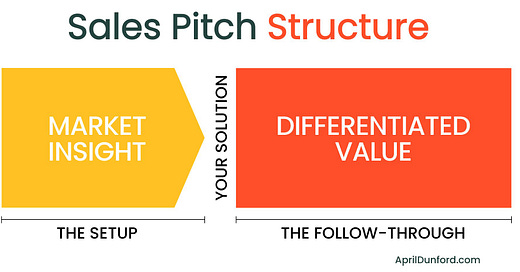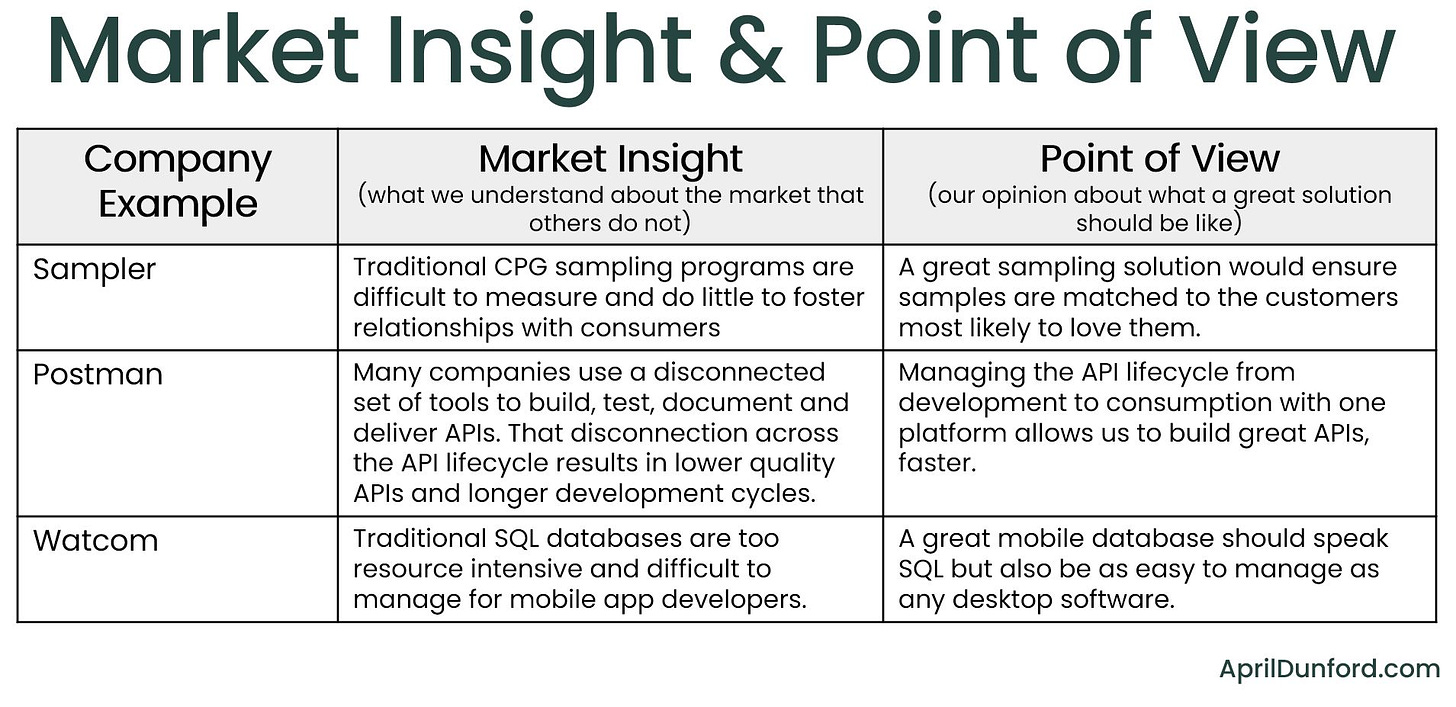This week, I wanted to expand on a topic I covered on my podcast a few weeks back: what is your company’s point of view, and how do we communicate that?
Most software has a built-in opinion about how a job should get done. When talking about the origin story of their product, most founders tell me the idea came from an observation that current approaches to a problem or task were lacking in some way. Getting the job done was too manual, too time-consuming, too error-prone, and too difficult for certain types of customers. The idea for the product was born from the team’s point of view that a different approach was simply “better” in some significant way.
Most successful products are an expression of an opinion about the market.
For example, Sampler’s founder, Marie Chevrier Schwartz, looked at how consumer packaged goods brands ran product sampling programs and developed the opinion that digital sampling would give brands a more targeted and effective way to get new products into the hands of customers who would likely become raving fans.
Abhinav Asthana and his co-founders at Postman observed that companies using separate tools to build, test, document, and distribute APIs often delivered low-quality, difficult-to-consume APIs. Postman’s point of view is that using a platform across the entire API lifecycle would be a dramatically better way to build and manage APIs.
Approximately 100 years ago, at Watcom (the first startup I ever worked for), we had understood that SQL databases were very difficult to set up and manage, too resource-intensive, and could only run on servers. Our point of view was that mobile application developers needed an SQL database that could sync with corporate databases but was as easy to install and manage as desktop software.
Your point of view on what makes a solution “good” is why you can deliver value that others cannot.
Your company’s point of view on how to approach a problem is the underpinning of your product’s differentiated value. Your product was built to approach the problem differently, ultimately delivering some value that the other approaches simply do not. Your point of view is why you built what you built the way you built it.
We stink at talking about our point of view.
You would think that since this point of view is so important for our differentiation, we would be great at communicating it in our sales and marketing efforts. Yet I have found that many companies aren’t great at talking about their point of view. Sometimes, I think we assume that because we have built a clearly superior solution, buyers will simply understand its inherent superiority once we show it to them.
Sometimes, that works, particularly where the end user is the buyer. But when we have a deal champion that isn’t an end-user, or we deliver truly unique value that customers have never experienced, we need to take customers on a journey to understand why we built what we built and what’s in it for them.
Market insight - helping customers understand our point of view
A point of view is generally rooted in a unique insight into the market. Our point of view is our opinion on what a great solution looks like. You can think of market insight as “the thing we understand about the market that the others do not.” It’s the knowledge about the market that led us to our point of view. Using the examples above, we can map insight to a point of view like this -
In general, your market insight is the thing your team had to learn to start thinking about the market differently. If we want customers to start to think about the market the way we think about it, we will have to help them understand this insight the way we do.
For this reason, I think communicating our market insight is the key to helping customers understand our point of view. In my sales pitch structure, we start with a discussion about our insight and then move to the differentiated value once we have established why the value matters.
How much do we need to “Challenge” customers?
In Matt Dixon and Brent Adamson’s groundbreaking book, The Challenger Sale, the authors propose that new market insight could significantly challenge the customer’s thinking. If we wanted to really teach customers, we should be prepared to spend some time and effort making the case that they understand something about the customer’s business that the customer themselves was blind to.
While this was definitely my experience when I was working at companies where we were doing massive 7-figure enterprise deals, I do not believe that our insight needs to be particularly “challenging” when we are selling 5-figure or even 6-figure deals. My experience is that often, it’s enough to simply point a spotlight at the insight.
Again, looking at the above examples - buyers don’t have a particularly hard time believing that digital sampling would have a set of advantages over manual random sample distribution. Most companies haven’t considered the root cause of their API quality and delivery issues. Application developers didn’t have a hard time imagining an SQL desktop database would be better than their existing options; they simply didn’t know it was possible.
Beyond the pitch - content can really drive this home.
Beyond the sales pitch, our marketing content should reinforce our market insight and point of view. The more prospects understand our thinking, the more they understand our value. I think Postman has done a great job of communicating their point of view across long-form content, market research, and even a graphic novel.
What do you think? Seen any good examples of this in action? Let me know what you think in the comments.
Other News
This week, I wrote a guest post for Lenny’s List (subscription required). The article is a good overview of my sales structure for those of you who haven’t read the book yet. His newsletter is so great - if you aren’t a subscriber already, you should check it out.
Last week on the podcast, I had Bruno Aziza (formerly running Google’s Data and Analytics business, currently a partner at CapitalG). We talked about the lessons learned from moving between startups and large companies - it was a fantastic conversation.
That’s it for this week! This newsletter is new, so feel free to tell your friends to subscribe. As always - I appreciate your support and feedback!
April






These posts couldn't be coming at a better time. Appreciate so much that you're sharing these ideas (and working my way through the book at the same time to learn them in detail). Thank you April!
Another great article April!
So many tech firms are founded by an inflection point or a point of view that gets exploited with a solution. These companies slowly acquire customers, grow and feel like they need to position themselves into spaces that appear to be unique or bigger.
All the while, the essence of that point of view gets lost. As new marketers (and members of other functions) join, the history gets rewritten with each person trying to put their spin on it. Happens all the time.
The same is true of the core problems that a solution solves. In the beginning, it is clear why the solution is quantifiably better but this too gets lost over time. In the end, it gets replaced by "feature fantasia" and category claims while the customer is left on their own trying to figure out the quantifiable outcomes that they can expect from the offering, let alone when they can expect them.